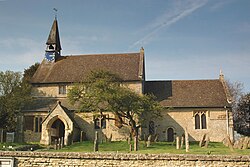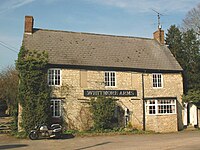Hethe
| Hethe | |
| Oxfordshire | |
|---|---|
 St Edmund & St George, Hethe | |
| Location | |
| Grid reference: | SP593294 |
| Location: | 51°57’36"N, 1°8’13"W |
| Data | |
| Population: | 279 (2001) |
| Post town: | Bicester |
| Postcode: | OX27 |
| Dialling code: | 01869 |
| Local Government | |
| Council: | Cherwell |
| Parliamentary constituency: |
Banbury |
Hethe is a village in the north of Oxfordshire, about four and a half miles north of Bicester.
The name of the village comes from the Old English hæð meaning "heath".[1]
History
Before and after the Norman conquest Wulfward the White, a thegn of King Edward the Confessor's Queen Edith, owned the manor of Hethe.[1] However, by 1086 William the Conqueror had granted the manor to Geoffrey de Montbray, who was both Bishop of Coutances and also one of William's senior military commanders.[1] By the 12th century the manor belonged to the Earls of Gloucester]], with whom it stayed until the 4th Earl died without a successor in 1314.[1] In 1347 the manor passed to the 1st Earl of Stafford.[1] It remained with the Staffords (who from 1402 were also Dukes of Buckingham) until 1521, when Edward Stafford, 3rd Duke of Buckingham was executed for treason and his properties were attainted to the Crown.[1]
At some time after 1167, St Bartholomew's Hospital in London was given a hide of land at Hethe.[1] In 1537 the hospital was dissolved under the dissolution of the monasteries and the Crown seized all its lands, but in 1547 the hospital was refounded.[1] The hospital retained its holding at Hethe at least as late as 1682.[1]
Hethe House was built in the 18th century.[1] It used to be a dower house for Shelswell.[1]
The parish was farmed under an open field system until 1772, when an Act of Parliament enabled its enclosure.[1]
Until the early part of the 19th century, the village public house was known as the Maltster's Arms. It was then renamed the Whitmore Arms, after Thomas Whitmore who lived at Hethe House 1808-11. It is a Grade II listed building.[2] Since 2012 it has been called The Muddy Duck.
A National School was built in 1852 and enlarged in 1874.[1] In 1924 it was reorganised as a junior school and in 1948 it was reorganised again as an infants' school.[1] In 1954 it was still open as a Church of England school,[1] but it is now closed. In 1831 land was bought to build a Roman Catholic school.[1] Building was begun then, but not completed until 1870 when it opened as St. Philip's School.[1] By 1920 it was an infants' school and in 1924 it was closed.[1]
Churches
The Church of England parish church, St Edmund and St George is known to have existed by 1154, when it was given to the Augustinian Priory at Kenilworth, later Kenilworth Abbey.[1] Both the west wall of the nave and the south wall of the chancel survive from this time, each retaining a Norman lancet window and the latter a priest's doorway from the same period.[3] The east end of the chancel was rebuilt early in the 13th century[3] when a Decorated Gothic east window was inserted.[4] In the 15th century a Perpendicular Gothic clerestory was added to the nave.[1] When the Abbey was dissolved in 1538 the advowson of Hethe passed to the Crown, which has retained it ever since.[1]
In 1854 Samuel Wilberforce, Bishop of Oxford complained that the St. Edmund and St. George was "in most miserable order" and "utterly too small for the population".[1] In 1859 the Gothic Revival architect George Edmund Street restored the building, widened the chancel arch, and added the bell-turret and the north aisle.[3] Street moved the Decorated Style east window from the chancel to the north aisle, and inserted a new east window in the chancel in its place.[4] The parish is now part of the benefice of Stratton Audley with Godington, Fringford with Hethe and Stoke Lyne.
The Old Rectory was in existence by 1679.[1] In 1928 it was refitted after being burnt out.[1]
A Roman Catholic church Holy Trinity, was built here in 1832 for the small number of Roman Catholics in the village, resuting from patronage by the owners of the estate, the Fermors. It is a Gothic Revival building.[4]
By 1794 Hethe had a small Methodist congregation.[1] It built its first chapel in 1854 and replaced this with a second chapel in 1876.[1] The latter was still being used as a chapel in 1955[1] but is now a private house.
Sport
- Football: Ashton Folly
Outside links
| ("Wikimedia Commons" has material about Hethe) |
References
- ↑ 1.00 1.01 1.02 1.03 1.04 1.05 1.06 1.07 1.08 1.09 1.10 1.11 1.12 1.13 1.14 1.15 1.16 1.17 1.18 1.19 1.20 1.21 1.22 1.23 1.24 1.25 1.26 Lobel, 1959, pages 174-181
- ↑ National Heritage List 1046454: Whitmore Arms Public House (Grade II listing)
- ↑ 3.0 3.1 3.2 Sherwood & Pevsner, 1974, page 645
- ↑ 4.0 4.1 4.2 Sherwood & Pevsner, 1974, page 646
- Blomfield, James Charles (c. 1890). Part V: History of Fringford, Hethe, Mixbury, Newton Purcell, and Shelswell. Deanery of Bicester. Elliot Stock & Co: London.
- A History of the County of Oxford - Volume 6 pp 174-181: {{{2}}} (Victoria County History)
- Nikolaus Pevsner: The Buildings of England: Oxfordshire, 1974 Penguin Books ISBN 978-0-300-09639-2
